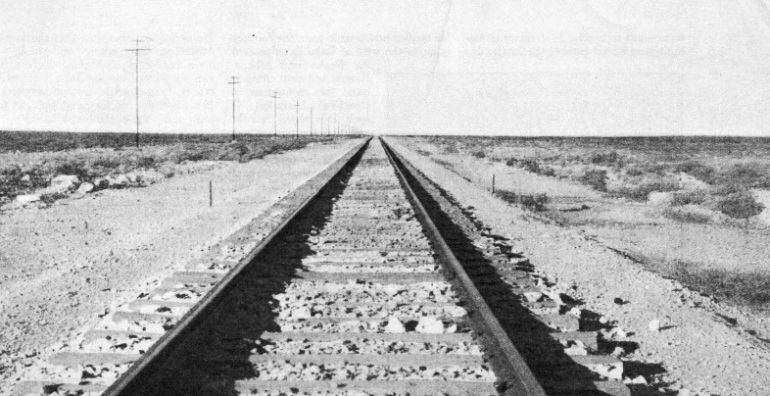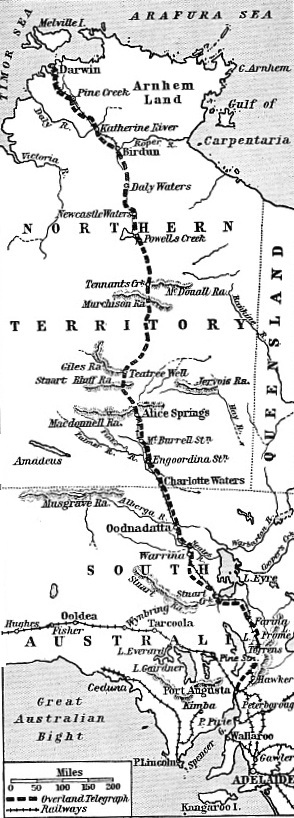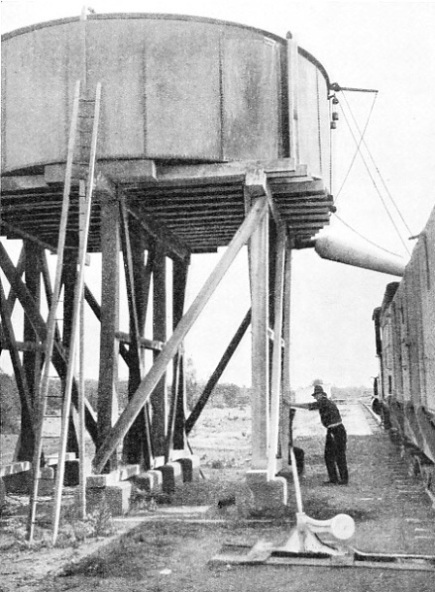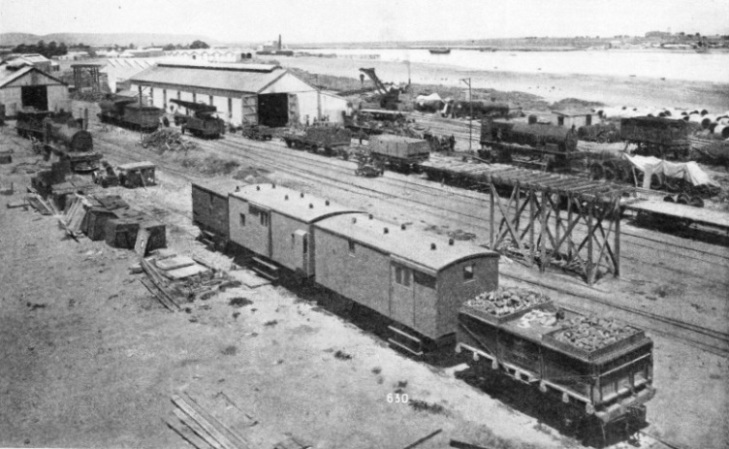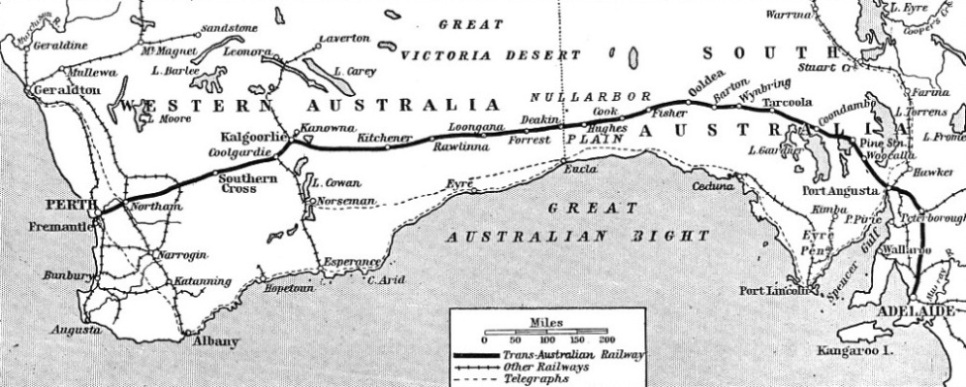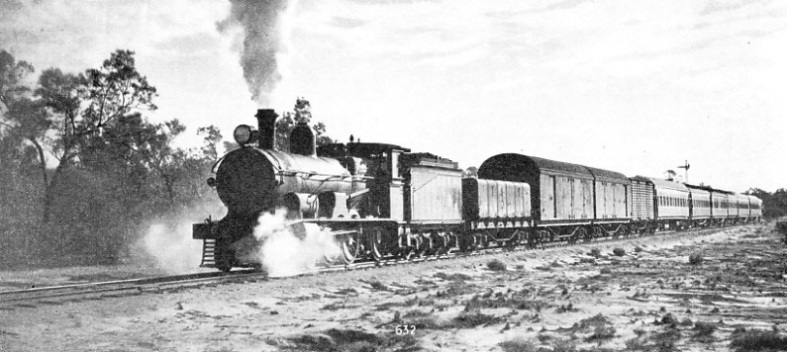


© Wonders of World Engineering 2014-


The remarkable interior of the vast Australian continent is even yet to a considerable extent undeveloped. In the wake of explorers, however, engineers have laid a north-south telegraph line and an east-west transcontinental railway
ACROSS THE NULLARBOR PLAIN, the Plain of No Trees, the Australian Transcontinental Railway has one stretch of 300 miles without a curve. Lack of water was a serious handicap for the builders of the line. Along the route of 1,051 miles the railway did not cross a single permanent stream of running water.
THE history of engineering in the vast spaces of the Australian interior is inextricably bound up with that of exploration. Many years elapsed between Captain Cook’s Australian discoveries and the planting of colonies round the fringes of the great island continent. Many more years elapsed before men knew anything of the vast and weird interior of Australia. There were vague tales of great rivers that flowed inland, instead of towards the sea, and lost themselves in the deserts; there were stories of huge salt lakes which had no known outlet.
Barren mountain ranges, scarcely capable of supporting life, we’re believed to exist. But the mid-Victorian Era lad been reached, and flourishing towns and ranches were to be found all over the south and east of the continent, before men dared to penetrate its mysterious inland regions.
Before 1872 there was no means of communication between the Northern Territory, formerly administered by South Australia, and the more populated parts in the south and south-east, except by steamers round the coast. The growing cities of New South Wales, Victoria and South Australia had no telegraphic connexion with the homeland.
Men went out into the desert and into the uncharted bush. Some of them returned with gloomy accounts of a pitiless country. Others never returned. A fearless pioneer was John McDouall Stuart, who made his first attempt to cross the continent from south to north in 1860. The first time he made his way into the unknown wastes he was defeated by illness. But it was only a temporary defeat to a man of his calibre. He tried again in the following year, and penetrated a long way into the arid and unpopulated interior, only to be turned back at last by a complete lack of water in the regions which he had attained.
After these two plucky attempts by Stuart followed the famous and tragic expedition of Burke and Wills. These two men, with their party, set off about the same time as Stuart had done on his first expedition. Far into the north they went, through dry ranges and all but impenetrable bush, ever pushing onward in the direction of the Gulf of Carpentaria on the north coast. Towards the end of the year a haggard party consisting of Burke, Wills, and two companions named Grey and King, with six camels and a horse, reached the Flinders River in the north of Queensland. They did not get as far as the sea, but they had penetrated sufficiently far to stand on the banks of the tidal reach of the Flinders.
Early in 1861 they were homeward bound, facing the sterile loneliness of the desert. They had been seven weeks on their way when Grey collapsed and died. Until the end of June 1861 the three survivors were wandering about in the desert. Then Burke and Wills succumbed, leaving King alone in the vast wildernesses. King was rescued and cared for by some friendly natives, among whom he was eventually found.
Next year the pitiless continent that had defeated man so consistently was at last defeated by man. For, in 1862, Landsborough crossed it from north to south, and McKinlay made the journey from south to north. In January of the same year Stuart entered the lists again. He headed northwards from the country lying to the west of Lake Eyre, crossed the Neales and Alberga Rivers, and went onwards into the mountains of Central Australia. It took him three months to reach the point where lack of water had driven him back before. In Australia the month of April comes between autumn and winter. Stuart refused to be daunted by the forces of Nature. He pressed on through thick bush lying in country hitherto utterly unknown to man, or at any rate to white men, until at long last he reached the basin of the Roper River, which flows into the Gulf of Carpentaria. From the aridity of parts of Central Australia he had come to a tropical region containing huge swamps and with a rainfall of over 70-in a year.
THE OVERLAND TELEGRAPH LINE across the Australian continent from Port Augusta, on Spencer Gulf, to Darwin, whence a submarine cable connects with Java. The line was built in three sections, one of which ran across the centre of the continent, traversing the Macdonnell Range. Railways have been built along the line of the telegraph southwards from Darwin to Birdun and northwards from Port Augusta to Alice Springs.
From the Roper area Stuart kept on, striking a north-westerly direction through Arnhem Land, until he reached the north coast, and the troubled waters of the Timor Sea lay before him. Herein lies the significance of Stuart’s journey. His course became that of the great overland telegraph, which was to link Adelaide with Darwin and with the submarine telegraph cable under the Timor Sea to Java. Stuart showed that such a south-to-north passage was possible, thus opening the way for a great line of Imperial communication.
After this courageous exploration, the States of Queensland and South Australia opened negotiations with the British-Australian Telegraph Company . The South Australian proposals were those finally carried into effect. The telegraph company agreed to lay a submarine cable from Java to Darwin, across the Timor Sea, on condition that the South Australian Government undertook to lay a connecting line along the course roughly plotted out by John McDouall Stuart, from Darwin to Port Augusta. The whole line, on land and sea, was to be open by the beginning of 1872.
In those days, South Australia, including the whole of the Northern Territory then administered by her, had a population of no more than 180,000 souls, yet she cheerfully agreed to foot the bill for building a telegraph line whose length was estimated at 1,500 miles and which was ultimately to cost about £300,000. Apart from the immediate line of Stuart’s route, the country was still quite unknown.
Lack of Water
The general superintendence of the enterprise was entrusted to Charles Todd, an Englishman who had been appointed Telegraph Engineer to South Australia in 1855, and who now occupied the position of Postmaster General and Superintendent of Telegraphs. Todd divided the route into three sections for construction purposes, letting the contracts accordingly. Section One extended northwards from Port Augusta at the head of the Spencer Gulf on the south coast. Section Two ran through the interior of Central Australia, traversing the pass through the Macdonnell Range which had been discovered by Stuart. Section Three was to run southwards from Darwin, linking up with Section Two on the north side at the mountains.
Todd suspected that Section Two would prove to be the most difficult and involve the most arduous work for the telegraph engineers, because of tit waterless nature of the country in which they would be working. Certainly those engaged on Section Two had no light task. Over long stretches - the Australian type of “long stretch”, covering hundreds of miles - the resources of Nature could not muster a single spring of fresh water, and the pioneers had to sink deep artesian wells into the stratum of New Red Sandstone which lay at a great depth below the surface.
Without this artificial source of water, communication, except in modem times by aircraft, could never have been established across the Australian Continent from south to north. Enormous tracts of land in Central Australia have now been made habitable, even pleasant for holidaymakers, by this means alone.
In addition to troubles through lack of water, the workers on the central section of the telegraph line were handicapped also by the immense distance over which they had to transport all their material and stock for feeding purposes, and also by the lack of timber. They had no railway, not even anything remotely resembling a cart track. Camels were of inestimable value to them. Yet this Section Two was not the most difficult of the three to build.
Rather unexpectedly to Todd and his engineers, Section Three, through the wilds of north Australia, proved to be the worst stretch. Whereas the men engaged on Section Two were hampered by lack of water, which was only what they had been expecting, those on Section Three were faced with a directly opposite problem. They had water, far too much water. Large tracts of north Australia, subject to rainfall of tropical dimensions, are so badly drained that they become a series of enormous swamps during the wet season.
There was, however, one disadvantage which the engineers were spared, namely, danger from hostile natives and from wild animals. Australia’s extraordinary fauna includes no huge beasts of prey, such as pioneers had to contend with in Africa, and the aboriginal natives, in spite of their primitive habits and peculiar customs, maintained an amiable front throughout. Not a single man lost his life through attack from unfriendly tribes.
36,000 Metal Telegraph Poles
Because of the unexpected hitch in the bush forests of the north, Sections One and Two were completed some time before Section Three. The engineers working on Section Three erected their first pole at Darwin on September 5, 1870, right at the beginning of the broiling southern summer. Their progress was dishearteningly slow, and nine months later Todd sent up a relief engineer at the head of eighty men to try to expedite the work. This party failed. The men were completely baffled by the endless floods in the steaming, tropical north. Todd made a rescue expedition at the head of another large force, but it was not until the rescuers had wandered for some time about the valley of the Roper River that they at last surveyed a satisfactory route across the hills to Darwin by way of Pine Creek.
On May 22, 1872, Todd sent the first message from Darwin to Adelaide. It was a mixed triumph, for part of the northern section of the line was still incomplete, and the inaugural telegram to be carried over long intervening stretches by relays of men on horse-back. Altogether that telegram took nearly a month to travel from Darwin to Adelaide. Exactly three months later the line was completed and the first through message was sped on its way. Meanwhile the cable company was having troubles of its own, and the submarine line across the Timor Sea was interrupted before the completion of the land line. It was not until October 22, 1872, that the first telegraphic message from London reached Adelaide. Shortly afterwards Todd rode down the entire length of the line and reported that it was in satisfactory condition.
Approximately 36,000 telegraph poles were needed for the line. In places where wooden poles would be liable to damage from bush fires, or from the ravages of termites (white ants), the Australian telegraph engineers used iron poles, and metal poles are now used throughout the length of the north-to-south telegraph line. There were many operations subsidiary to the installation of the line. Those who went before had to clear the bush and scrub, in overgrown places, to an average width of 50 feet over 500 miles of the route, and all the building stone subsequently used for intermediate telegraph stations had to be transported without railway or even wagon tracks. The first station was erected at Darwin. The intermediate stations, situated at intervals of about 200 miles, came later.
It might have been expected that the next great link in the communications of Australia would be a transcontinental railway following the line of Charles Todd’s overland telegraph. Part of the route, certainly, has been followed by a railway, but not all of it. There are certain important reasons for this. To begin with, unless Darwin were to become a major port, the north-to-south railway would carry a rather small traffic, for Darwin is not a big place. Then the air liner has appeared as a new factor in transcontinental transport, and this now carries the special fast traffic that might at one time have travelled by rail from Adelaide and Port Augusta to Darwin for destinations beyond the Timor Sea and the Indian Ocean.
At a comparatively early date, however, the North Australia Railway was built along the line of the telegraph from Darwin to Pine Creek. The Act of Parliament for the building of a direct north-to-south railway dates from 1910, and bit by bit the railhead extended southwards from Pine Creek through the strange country that had all but baffled Stuart and Todd.
LARGE WATER TANK from which locomotives draw water on the long journeys across the arid regions of the Australian continent. The pioneers who built the railway lines had to sink artesian wells, sometimes to a depth of more than 1,000 feet, to obtain water.
Progress was slow. The builders of the line reached Katherine River in 1917. On September 4, 1929, they had reached Birdun, which remained by 1937 the railhead of the North Australia line.
From the southern railhead at Oodnadatta, the engineers pushed forward with the Central Australia Railway, and opened the first twenty-one and a quarter miles on August 29, 1927. They continued into the area of what had been Section Two of the telegraph line and finally reached Alice Springs on August 2, 1929. Alice Springs and Birdun remained, in 1937, the two “loose ends” of what may some day become a second transcontinental route, but the lines in question have been of tremendous value to those who have sought their fortune and found it in the wilds of the Australian interior.
Lakes which Disappear
The great transcontinental route in Australia is the railway built by the Commonwealth Government. The line runs from east to west and brings Perth, the capital of Western Australia, into direct communication with the great cities of the eastern States. It traverses an extraordinary region. There is nothing similar to it in any other part of the world. For over 300 miles in a dead straight line, the route crosses the desert known as the Nullarbor Plain, the Plain of No Trees.
The Nullarbor Plain, which extends altogether for 450 miles, consists of an almost level area of limestone, with slight undulations, and covered with little more than a foot of dry, red soil. It is not entirely flat, for in addition to the gentle rise of the surface there are shallow dongas or depressions, containing a little more soil than elsewhere, in which grass and scrub grow in a sort of parched luxuriance during the spring. The dongas are at their rarest in the utterly arid central parts of the plain. Its only lakes are a few salt pans, which glisten with bright blue water for a short while every year before rapidly returning to their normal dry condition.
The plain contains innumerable subterranean caverns, some of enormous size, in which its bird life, including thousands of owls, shelter in the heat of the day. There are many strange creatures which seem to thrive in this weird region, such as lizards which express their disapproval by standing up on their hind legs and barking as a small dog would. The area of the Nullarbor Plain has been estimated at about 100,000 square miles. But the Nullarbor Plain was not the only difficult stretch with which the builders of the Trans-Australian had to deal. For 1,051 miles, throughout the length of the route, their line did not cross a single permanent stream of running water. They had to face summer temperatures of 130 degrees Fahrenheit in the shade, and make the most of an annual rainfall which was, at the best, about 4 inches.
REPAIR SHOPS in connexion with the building of the Australian Transcontinental Railway were built at Port Augusta, at the head of Spencer Gulf. Work on the line to Kalgoorlie began from Port Augusta on September 14, 1912.
The route of the Trans-Australian Railway passes through four distinct areas. From west to east, first there is a plateau of granitic rock stretching eastwards from Kalgoorlie for 167 miles. This plateau is well wooded with eucalyptus and other aromatic trees. The wooded area ends abruptly where the granite dips below the limestone forming the bed of the Nullarbor Plain. Thereafter, for 450 miles, there is not a tree to be seen, save on some ridges bearing black oak and a few other stunted trees. The “trees” of the Nullarbor Plain consist of bluebush and saltbush, mere stunted shrubs, or an occasional dwarf acacia. For 500 miles nothing else is seen until the route approaches the 50-miles belt of sandhills bounding the eastern side of the plain, where trees some 10 feet high seem to be giants after the scrub recently encountered.
This sandhill district forms the third area of the route. It is succeeded by a country of plains which extends for the remainder of the line as far as Port Augusta. The first man to make the passage of this district was Edward J. Eyre who, in spite of the fearful climate, the lack of aids to desert travel then prevailing, and the attentions of innumerable voracious insects, made the journey round the Great Australian Bight in 1840. In 1870, John Forrest, afterwards Lord Forrest, explored the plain itself, taking five months to complete his journey.
It was not until the early years of the present century, however, that the possibility of east-to-west communication seemed ripe for exploitation. By building an overland route to Perth whence ran a line to the port of Fremantle, modern engineers were able to effect a substantial reduction in journey time, not only for purely internal passengers and freight consignments, but also for those travelling to and from destinations beyond the Indian Ocean.
The year 1908 saw the sending out of two survey parties, one from Port Augusta and the other from Kalgoorlie. Pack camels provided their transport. The stars, which shine with great brilliance in that intensely dry climate, enabled them to correct their compass bearings. Each party worked slowly towards the other, their common destination being the State boundary between South Australia and Western Australia near what is now Deakin.
Three Miles a Day
The South Australian party experienced terrible hardships through lack of water, yet they managed to average three miles of survey a day. The party from Western Australia were able to progress at nearly double that speed, and took from July 1 to September 27 to peg out 455 miles of route between Kalgoorlie and the border. To the last beast in their train of ninety-one pack camels they attached a heavy drag chain, which marked out a rough line across the desert. The party from Port Augusta reached the boundary point on March 13, 1909. The preliminary survey for the “Trans” had been carried out.
It was one thing to plot out a rough course, but it was quite another to build a railway line, even across the flat width of the plains. Port Augusta is 21 feet above sea level, and the route rises gradually to 1,326 feet 101 miles east of Kalgoorlie. First and foremost there was the old trouble, lack of water. There was a limited amount at Port Augusta. Kalgoorlie had no water of its own, but derived its supply from the Mundaring Weir, 350 miles away. Over the whole stretch between Port Augusta and Kalgoorlie, the engineers who preceded the builders of the line had to bore for their water. Moreover, when they reached the water, it was often so salty that it could be used only for stock and was hopeless, in its raw state, for use in boilers.
They experienced good luck at a point about 210 miles from Port Augusta, where they obtained excellent water from a depth of no more than 60 feet, the boring giving an average yield of 60,000 gallons a day. But over one complete stretch of 150 miles they could obtain nothing but saline water, every drop of which had to be distilled before it could be used in a boiler.
The deepest artesian wells sunk by the pioneers of the “Trans” went down to 1,470 feet below the surface. These deep wells were not gushers. Pumps had to be requisitioned before they yielded anything. Even when the water had reached the surface, special precautions had to be taken to prevent its being rapidly evaporated by the heat and dryness of the surrounding air. Anything in the nature of an open reservoir was out of the question. The water was stored in great tanks of cement concrete, completely roofed over.
THE TRANS-AUSTRALIAN RAILWAY links Fremantle and Perth, capital of Western Australia, with Adelaide, capital of South Australia, whence rail communication is continued to Victoria, New South Wales and Queensland. The section from Kalgoorlie to Port Augusta, across the Nullarbor Plain, was built in face of great difficulties, under the direction of Colonel Norris Bell, and completed in 1917.
Colonel Norris Bell was the Engineer-in-Chief of the enterprise. To carry out a work such as this, the chief had to be a born organizer and understander of men, as well as a thoroughly competent engineer. Colonel Bell fulfilled all these necessary qualifications. He was a man of great modesty, yet of untiring strength of purpose. He did not work his men, he worked with them, and where the conditions were at their worst, there Norris Bell would be found.
Work began first on the section out of Port Augusta, on September 14, 1912. Operations at the western end were inaugurated just over five months later. The surveyors were followed by gangs engaged in clearing the scrub along the line of the route. Then came the men engaged in the grading of the track.
Despite the flatness of much of the route it proved necessary for the graders to handle about 5,000,000 cubic yards of rock and earth. Following the graders came the track layers. At first the track layers used hand methods, twenty-seven miles of metals being laid thus from Port Augusta and twelve and a half miles from Kalgoorlie. Then Colonel Bell brought huge mechanical track-layers into play, and these pushed forward to meet one another across an intervening gap of about 1,000 miles of desert. The final gang, which followed those engaged in track laying, dealt with the packing of the permanent way and the smoothing out of inequalities.
One of the worst stretches on the whole route was not on the Nullarbor Plain, but across the sandhill stretch in South Australia. The heat was terrific, making it impossible to work in the middle of the day. Men tried to shelter in the huts and service cars, for there was often no other real shade. But as often as not this merely involved exchanging an open furnace for an equally unbearable oven, and long-suffering navvies might be seen who had buried themselves up to the neck in the sand in an effort to escape the fierce rays of the sun.
Bell himself has described how it was impossible to use either pen or pencil in the heat of the day. The ink dried in the flow of a fountain pen, it dried on the nib of an ordinary pen, and the wooden shaft of a pencil contracted to such an extent that the lead could easily be tipped out. Then the men were tortured by the biting and stinging insects. The sufferers had to be treated in travelling clinics attached to the camp trains which followed the construction trains forward. The men were well cared for and they deserved it. Fresh fruit, fish, and vegetables reached them daily, by refrigerator car, even though they were hundreds of miles out in the scorching desert.
Completed in Five Years
It was expected that the two great parties would meet and complete their stupendous work about 1915, but the outbreak of war on August 4, 1914, caused a heavy drain on skilled labour. Raw recruits had to be pressed into service and taught their job, in these most arduous conditions, as they went along. Another serious result of hostilities was the scarcity and soaring price of steel rails, which were sometimes unobtainable. Little by little, in spite of all difficulties, natural and political, the brave gangs bore onward across the Nullarbor Plain to meet one another.
On October 17, 1917, the two great working parties met in the middle of the vast desert and the two railheads were at last connected, forming a complete standard gauge railway between Port Augusta and Kalgoorlie, and giving rail communication, unbroken except by variations of gauge, between Brisbane in Queensland and Perth and Fremantle in Western Australia. On October 22, the first train left Port Augusta for the west and the “Trans” was at last open.
Altogether the work had taken just a month over five years to carry out, apart from the preliminary surveys. It involved the use of about 2,500,000 sleepers and 140,000 tons of flat-bottomed steel rail, and had given employment to more than 2,500 men at once. It had broken one of the most tremendous natural barriers across the communications of the Empire. When the first through service began, the journey time between Melbourne and Perth, by way of Adelaide, was shortened by no less than three days, despite the fact that speeds on the “Trans” were necessarily low.
The courage and endurance of Australia’s engineers enabled them to conquer the vast desert wastes, and to bring Western Australia out of the isolation into which Nature had forced her hitherto. Moreover, the engineers brought water to a formerly waterless region, and the region is gaining a new character which Edward Eyre and Forrest could never have foreseen.
THE TRAIN ACROSS AUSTRALIA is composed mainly of corridor coaches, including dining car, lounge and sleeping cars. Two trains run regularly every week in either direction, but there are also many special passenger trains. The gauge from Kalgoorlie to Port Augusta is the standard gauge of 4 ft 8½-in.
[From part 21 and part 22, published 20-27 July 1937 ]
You can read more on “Across Australia by Train”, “Australian Engines”, and “Travel in Australia” in Railway Wonders of the World.
